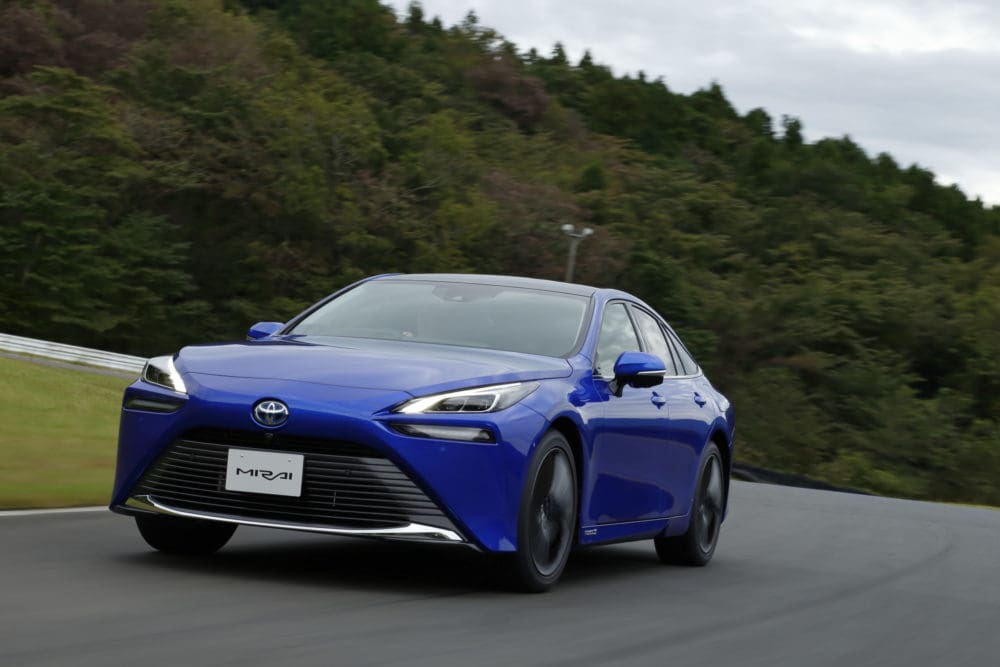



The company says a comprehensively redesigned fuel cell system, intelligent packaging and aerodynamic efficiency help extend the driving range to around 400 miles, with no other emissions than pure water.
Improvements in performance and design
A priority has been to improve its driving range compared to the first generation model and going beyond the distances typically achieved by battery electric vehicles. Increased power and hydrogen fuel capacity, improved efficiency and better aerodynamics all contribute to extending the driving range by 30 per cent to around 400 miles.
Packaging has also been improved with the new Mirai built on Toyota’s modular GA-L platform. A more efficient and well-balanced arrangement of the new FCEV powertrain – notably with the fuel cell stack moved from beneath the cabin to the front compartment – has allowed for a more spacious, five-seat interior with improved legroom for rear seat passengers.
Overall height has been reduced by 65 mm to 1,470mm, and there is a 140mm increase in the wheelbase (2,920mm). With the rear overhang extended by 85 mm, overall vehicle length is now 4,975mm. A 75mm increase in the track width and the use of larger, 19 and 20-inch wheels add to the lower and more dynamic stance and visual sense of the new Mirai’s lower centre of gravity.
GA-L platform
Adopting the GA-L platform has allowed the fuel cell stack and drivetrain components to be repackaged in a way that makes more efficient use of space. It enables three high-pressure hydrogen tanks to be fitted, increasing fuel capacity and the car’s driving range – by 30 per cent.
The tanks are arranged in a “T” configuration, the longest running longitudinally and centrally beneath the vehicle floor, with two smaller tanks set laterally beneath the rear seats and luggage compartment. Together they can hold 5.6kg of hydrogen, compared to 4.6kg in the current Mirai’s two tanks. Their position contributes to the car’s lower centre of gravity and avoids compromising load space.
The new architecture also permits the all-new hydrogen fuel cell to be moved from its current location beneath the floor to the front compartment (equivalent to the engine bay), while the (more compact) high-voltage battery and electric motor are positioned above the rear axle.
The tanks have a stronger, multi-layer construction and are highly weight-efficient – the hydrogen accounts for 6 per cent of the combined weight of the fuel and tanks.
New fuel cell stack
Toyota’s new fuel cell stack and fuel cell power converter (FCPC) have been developed specifically for use with the GA-L platform. The designers have been able to bring all the elements together in the stack frame (including the water pumps, intercooler, air conditioning and air compressors and the hydrogen recirculation pump) with each part made smaller and lighter, while at the same time improving performance. The stack case itself has been made smaller by using Friction Stir Welding, reducing the gap between the fuel cell and casing.
The fuel cell stack uses a solid polymer, as in the current Mirai, but has been made smaller and has fewer cells (330 instead of 370). Nonetheless, it sets a new record for specific power density at 5.4 kW/l (excluding end plates). Maximum power has thus risen from 114 kW to 128 kW. Cold weather performance has been improved with start-up now possible at temperatures from as low as -30˚C.
Lithium-ion battery
The new Mirai is equipped with lithium-ion high-voltage battery in place of the current model’s nickel-metal hydride unit. Although smaller in size, it is more energy-dense, giving higher output and superior environmental performance. Containing 84 cells, it has a 310.8 rated voltage compared to 244.8, and a 4.0Ah capacity, versus 6.5Ah. Overall weight has been reduced from 46.9 to 44. kg. The output has improved from 25.5kW x 10 seconds to 31.5kW x 10 seconds.
The battery’s smaller dimensions have allowed it to be positioned behind the rear seats, avoiding intrusion in the load compartment. An optimised air-cooling path has been designed, with discreet inlets either side of the rear seats.
Targeting a 10-fold increase in sales
The introduction of the new Mirai will see Toyota target deeper market penetration with a planned 10-fold expansion in sales volume. The company says this growth will be supported by the new model’s stronger performance and greater customer appeal, notably as a more affordable vehicle with a selling price reduced by around 20 per cent.
Toyota believes the practicality of hydrogen FCEV ownership will also steadily increase as markets improve their hydrogen infrastructure, the number of filling stations rises and Governments and local authorities introduce new incentives and regulations for cleaner mobility.
© Motorworld Media 2023
Registered Office: 4 Capricorn Centre, Cranes Farm Road, Basildon, Essex. SS14 3JJ
Company Number: 8818356
Website designed by Steve Dawson
2 Responses
When is the possibility of this being available in RHD In the UK? & what filling points will be available?
It arrives next spring and will cost in the region of £60k to £65k. The choice of hydrogen stations is still quite limited sadly 🙁